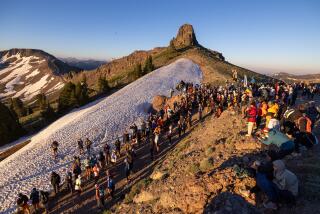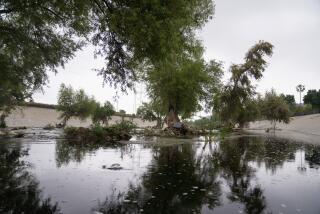ON THE WATERFRONT : Colorado’s Arkansas River Is Scenic Location of America’s Most Spectacular Kayak Race
- Share via
SALIDA, Colo. — Deglen O’Drisceoil, 20, of Dublin, Ireland, was drenched by towering waves as he maneuvered his 13-foot kayak through the treacherous Cottonwood Rapids on the Arkansas River.
A few hundred spectators watching from atop huge boulders along the riverbank whooped it up, yelling, clapping and cheering.
O’Drisceoil fought every inch of the way through the violent, churning river, doing everything in his power to stay afloat. His face was contorted as he attempted to make it through this final hurdle in the toughest, longest, oldest, kayak race on earth.
They call it the FIBArk--First In Boating on the Arkansas--and this was the 37th running of the 26.7-mile race down the swollen Arkansas River from the old mining camp that is now Salida to the small town of Cotopaxi.
Melting snows feed hundreds of streams that pour into the Arkansas River, giving 30 of the world’s leading kayak racers one of the wildest rides of their lives.
O’Drisceoil, one of three members of the Irish National Kayak Team competing in the race, made it safely through the rapids. The rest of the course--four miles downriver to the finish line at the Cotopaxi Bridge--was comparatively simple.
O’Drisceoil finished 12th in 2:06.15, completing the course without being thrown into the bone-chilling waters.
“I’ve kayaked throughout Europe, in the Alps of Germany, Switzerland and Italy,” he said, “and there’s nothing that can compare to this race.”
European championship kayak races are only 4.9 miles in length in rivers not nearly as hazardous.
Winner of this year’s FIBArk was Andy Corra, 24, of Durango, Colo., a member of the U.S. National Kayak Team, who finished the course in 1:55.35, the third-best time on record. Five of the eight members of the U.S. team were in the race.
Corra, a student at Fort Lewis College in Durango, spun around in the Cottonwood, the most feared and powerful of the 25 rapids on the river, but managed not to spill. Others were not as fortunate.
Chris Byars, 45, competing for the 10th time, was sent flying out of his kayak and barely missed the rock walls of the canyon. Undeterred, he climbed back into his kayak without help and completed the race.
Two other kayaks entered the rapids, spun around and almost collided. Then, they flipped simultaneously, spilling David Scheuerman, 26, of Vail, and Arney McCoy, 18, of Salida. Safety divers leaped into the river to rescue them, but they came up on their own and went on to finish the race.
McCoy’s mother, Cheryl, 40, was among the 300 spectators on the pile of boulders flanking the rapids. “I was scared to death. I was afraid Arney and Dave were never going to come up. I had never seen Arney race before. Never seen him go through rapids,” Cheryl McCoy said as she greeted her son at the finish line.
The competitors know the dangers of the river. Just the the day before, one of the divers, Bill Taylor, a 25-year-old former Navy frogman, drowned while swimming in the annual eight-mile safety diver race.
Taylor’s head slammed into a submerged Cottonwood tree two miles into the race. He was knocked unconscious and drowned before he could be rescued.
Taylor’s death was the first at a FIBArk event since a kayaker drowned in the competition 25 years ago.
Pete Makris, 37, of Buena Vista, Colo., former member of the U.S. National Kayak Team, explained the rules of the race. “The most important part is safety,” Makris said. “If anyone is in trouble, the first responsibility of all competitors is to go to the aid of that person. Forget the race. You would be disqualified if you don’t.”
A dozen members of the Puebla-based Colorado Gypsy Divers sport diving team--10 men and two women--have served as safety swimmers at the FIBArk every year for 20 years. If any of the kayakers run into trouble and need help, divers stationed at the more treacherous rapids go to their assistance.
Four of the 30 competitors in this year’s race were women, three of them members of the West German Women’s National Kayak Team. Two weeks earlier, they had placed first, second and fourth, respectively, in the women’s wildwater world championships at the Bavarian resort town of Garmisch-Partenkirchen.
They did well in the FIBArk race, too. Karen Wahl, 21, a bank receptionist and the world’s No. 1-ranked woman kayaker, won the women’s race in 2:02.46; Andrea Hotzendorfer, 22, a secretary, finished in 2:04.32, and Dagmar Volke, 24, 1983 world champion finished in 2:04.39.
Corra was something of an upset winner in the men’s division. Gary Lacy, 29, of Silverthorene, Colo., was the pre-race favorite, having won the event in 1976, 1977, 1979, 1983 and 1984. Lacy’s 1983 winning time of 1:52.36 was the best-ever. This time, he could do no better than third.
Second place went to Fletcher Anderson, a cameraman from Glenwood Springs, Colo. Anderson has competed in the FIBArk a dozen times. His wife, Ann, 34, has placed first among women in 1976, 1977, 1979 and 1980. His father, Denver attorney Keith Anderson, was in the race in 1951.
Fletcher Anderson is the current kayak racing national champion and, at 37, the old man of the U.S. National Kayak Team.
Several hundred people watched the kayakers paddle down 26.7-mile course. They, picnicked, sat in cars and pickups above the riverbank, on rocks, and on foot and vehicle bridges.
Kayakers rowed and were carried by the rushing waters through open meadows, narrow rock-rib canyons, through tiny mountain towns, Wellsville, Swissvale, Howard, Coaldale and finally Cotopaxi, named after an Ecuadorian volcano by a 19th Century miner who mined in both Colorado and South America.
At a bend in the river below Swissvale, the kayakers sailed around a lone fly fisherman who seemed oblivious to the race.
The skills of the experienced competitors such as Anderson boaters were especially tested at the bigger rapids, Barrel, Slanting Rock, Badger Creek, Whitehorse, Tin Cup, Red Rocks, Railroad, Cottonwood and Little Cottonwood.
At Salida, the elevation is 7,200 feet. At the Cotopaxi Bridge, where the race ends, it is 6,300 feet. The race began on a warm sunny June day. By the time the kayakers reached Cottonwood rapids, there was thunder, lightning and rain.
There are thousands of kayakers in this country, but only 760 are members of the American Canoe Assn., kayakers who race in sanctioned events such as the FIBArk. The rapids and the length of this race are so strenuous, so demanding, that only the very best enter.
Kayaking for sport began in the southern portion of Germany around the turn of the century.
By the end of World War II, whitewater kayaking competition was well developed throughout Europe. The first world championship kayak slalom was held in Switzerland in 1949.
That year, Salida became the center of whitewater sport in the United States when the first race was held. Then, it ran from Salida through the Royal Gorge to Canon City, a distance of 56 miles.
Only one boat finished in the first FIBArk. Several were destroyed when they smashed into the rocks. Another sank in the Royal Gorge. Afterward, it was decided to shorten the race by eliminating the passage through Royal Gorge.
During the ensuing years the FIBArk, the most challenging of all the whitewater kayak downriver races, has been won by 18 Americans and 17 Europeans. Coloradans have won 12 of the races, Californians, six. The California winners were Bob Ehrman of Cloverdale, Art Viteralli of Newport Beach and Gunter Hammersbach of Los Angeles.
More to Read
Sign up for The Wild
We’ll help you find the best places to hike, bike and run, as well as the perfect silent spots for meditation and yoga.
You may occasionally receive promotional content from the Los Angeles Times.






